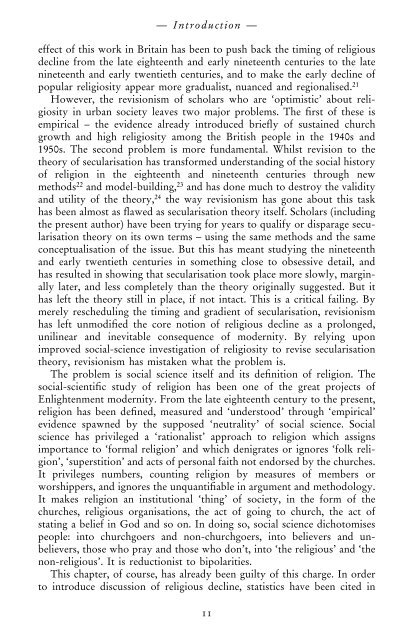The Death of Christian Britain
The Death of Christian Britain
The Death of Christian Britain
You also want an ePaper? Increase the reach of your titles
YUMPU automatically turns print PDFs into web optimized ePapers that Google loves.
— Introduction —<br />
effect <strong>of</strong> this work in <strong>Britain</strong> has been to push back the timing <strong>of</strong> religious<br />
decline from the late eighteenth and early nineteenth centuries to the late<br />
nineteenth and early twentieth centuries, and to make the early decline <strong>of</strong><br />
popular religiosity appear more gradualist, nuanced and regionalised. 21<br />
However, the revisionism <strong>of</strong> scholars who are ‘optimistic’ about religiosity<br />
in urban society leaves two major problems. <strong>The</strong> first <strong>of</strong> these is<br />
empirical – the evidence already introduced briefly <strong>of</strong> sustained church<br />
growth and high religiosity among the British people in the 1940s and<br />
1950s. <strong>The</strong> second problem is more fundamental. Whilst revision to the<br />
theory <strong>of</strong> secularisation has transformed understanding <strong>of</strong> the social history<br />
<strong>of</strong> religion in the eighteenth and nineteenth centuries through new<br />
methods 22 and model-building, 23 and has done much to destroy the validity<br />
and utility <strong>of</strong> the theory, 24 the way revisionism has gone about this task<br />
has been almost as flawed as secularisation theory itself. Scholars (including<br />
the present author) have been trying for years to qualify or disparage secularisation<br />
theory on its own terms – using the same methods and the same<br />
conceptualisation <strong>of</strong> the issue. But this has meant studying the nineteenth<br />
and early twentieth centuries in something close to obsessive detail, and<br />
has resulted in showing that secularisation took place more slowly, marginally<br />
later, and less completely than the theory originally suggested. But it<br />
has left the theory still in place, if not intact. This is a critical failing. By<br />
merely rescheduling the timing and gradient <strong>of</strong> secularisation, revisionism<br />
has left unmodified the core notion <strong>of</strong> religious decline as a prolonged,<br />
unilinear and inevitable consequence <strong>of</strong> modernity. By relying upon<br />
improved social-science investigation <strong>of</strong> religiosity to revise secularisation<br />
theory, revisionism has mistaken what the problem is.<br />
<strong>The</strong> problem is social science itself and its definition <strong>of</strong> religion. <strong>The</strong><br />
social-scientific study <strong>of</strong> religion has been one <strong>of</strong> the great projects <strong>of</strong><br />
Enlightenment modernity. From the late eighteenth century to the present,<br />
religion has been defined, measured and ‘understood’ through ‘empirical’<br />
evidence spawned by the supposed ‘neutrality’ <strong>of</strong> social science. Social<br />
science has privileged a ‘rationalist’ approach to religion which assigns<br />
importance to ‘formal religion’ and which denigrates or ignores ‘folk religion’,<br />
‘superstition’ and acts <strong>of</strong> personal faith not endorsed by the churches.<br />
It privileges numbers, counting religion by measures <strong>of</strong> members or<br />
worshippers, and ignores the unquantifiable in argument and methodology.<br />
It makes religion an institutional ‘thing’ <strong>of</strong> society, in the form <strong>of</strong> the<br />
churches, religious organisations, the act <strong>of</strong> going to church, the act <strong>of</strong><br />
stating a belief in God and so on. In doing so, social science dichotomises<br />
people: into churchgoers and non-churchgoers, into believers and unbelievers,<br />
those who pray and those who don’t, into ‘the religious’ and ‘the<br />
non-religious’. It is reductionist to bipolarities.<br />
This chapter, <strong>of</strong> course, has already been guilty <strong>of</strong> this charge. In order<br />
to introduce discussion <strong>of</strong> religious decline, statistics have been cited in<br />
11








